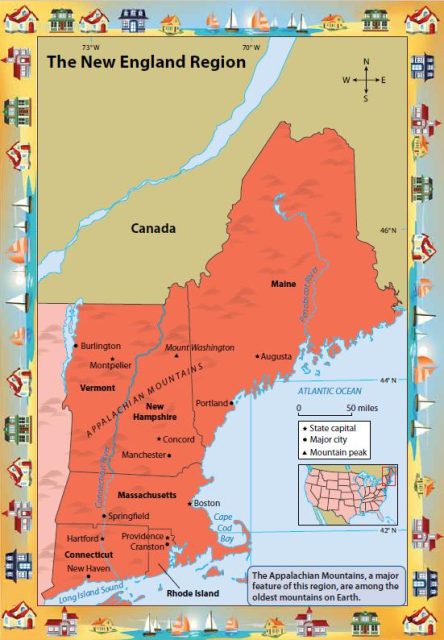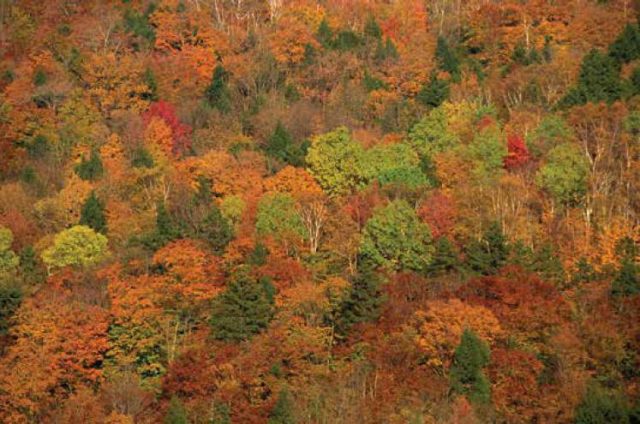New England
Exploring New England We began our exploration of the United States in the region called New England. This region is in the northeastern part of the United States. It is made up of six states: Maine, New Hampshire, Vermont, Massachusetts, Connecticut, and Rhode Island. The Atlantic Ocean borders all of these states except one—Vermont. In addition to the ocean, there are also mountains, hills, forests, and lakes in New England. Lieutenant Koola landed our ship in a forest clearing close to a town. The town had many wooden houses and a small harbor with sailboats. Because we were disguised as humans, the people we met were friendly toward us.
We were hungry after our long journey across the ocean, so we asked someone to recommend a good place to go for a meal. As you know, one of the things we like to find out about a place is what food the people who live there eat.

When we were all seated in a nearby restaurant, we decided to try one of the area’s special foods. The server said, “What about some lobster?” Because we had never heard of lobster, we thought we should give it a try.
Imagine our surprise when the server brought each of us a red, bug-like creature with long antennae and mean-looking claws. By talking to the server, we learned that lobsters come from the sea, so they are not really bugs. We were relieved to hear that! The server mentioned that many people in this part of Maine make their living by catching lobster. We asked him where we could go to find out more about the area. He said, “You could try the public library.” We did not know what a public library was, but we were curious. The waiter gave us directions, and after we left the restaurant, we went to find the library.

Learning at the Library
The library turned out to be a brick building on the main street in town. When we went inside, we realized that we had made a great discovery. A public library, Admiral, is a place full of books and magazines where people can go to read without paying anything. Public libraries also have computers. In a public library, you can find information on any subject.
In America, there are thousands and thousands of these libraries. Almost every town or city has at least one. As soon as we found this out, we realized that we had another wonderful way to find information. We might even visit the public library in every new place we visit.
In terms of climate, New England has four very different seasons. It has a cool spring, a warm summer, a crisp fall, and a long, cold, snowy winter.
You may wonder why the area is called New England. It is because in the 1600s, people from England crossed the Atlantic Ocean and settled in the area. They also settled farther south, all the way down the Atlantic Coast. In fact, thirteen English colonies were established. Over time, building ships and fishing became important industries in New England.
Then, in the late 1700s, many people in the thirteen colonies decided they wanted to be independent. They wanted to start a country of their own. In the year 1776, they declared their independence from Great Britain. The colonists fought a war against Great Britain for their freedom, which the Americans call the Revolutionary War. It is also known as the American Revolution. The colonists defeated the British and called their new country the United States of America. Although their country is not part of Great Britain anymore, the people of the United States did keep the English language, which is spoken by almost all Americans today. After a few days of studying in the library, we were anxious to begin exploring again. We knew that we would miss the small Maine town and its kind people. Even more, we would miss the delicious lobster.
Mountains and Skyscrapers
After taking off, we turned the ship southwest, toward the mountainous states of New Hampshire and Vermont. Flying low over the mountains, we were greeted by a spectacular sight. Because in the Northern Hemisphere it was Earth’s season of autumn, the trees’ green leaves had changed color. Some of the trees were gold, some red, some purple. Every hillside was ablaze with different colors.
As we flew down for a closer look, Lieutenant Koola pointed to some of the most brilliantly colored trees. “Do you see those trees?” she asked. “A book I was reading said that those are sugar maples. A sweet liquid called maple syrup is made from the sap of those trees.” You really have to hand it to the Americans, Admiral. They seem to be able to make tasty food out of almost anything—even tree sap and big bugs from the ocean!

From Vermont, we flew south, across the western part of the state of Massachusetts. There, we enjoyed the sight of more rolling hills and colorful trees. But we were eager to see the city of Boston, which we knew was the capital of Massachusetts and the biggest city in New England. So we turned back east, toward the coast. Boston looks nothing at all like the small town we visited in Maine. It is a huge, busy city full of tall modern buildings called skyscrapers. But parts of the city are very old. In fact, Boston was one of the first important cities in the country. When we went to Boston’s public library to study, we discovered that it was the oldest public library in the United States. We also learned that there is a local university called Harvard, which was the first college founded in America. Today, Boston is famous for being a center of education, with dozens of colleges scattered around town.
Boston is also a city full of history. The American Revolution broke out in the Boston area. When we walked through the city on the Freedom Trail, we saw many places that are important in the story of the American Revolution.
We visited Faneuil Hall, an old brick building where revolutionaries gave speeches against the British. We also saw the house of Paul Revere. When British troops began to march toward Concord to try to capture certain revolutionaries, Revere rode out in the middle of the night to warn people that the British were coming. A famous old poem talks about “the midnight ride of Paul Revere.”
We could have spent a lot more time in Boston, but we knew we had to fly on and explore the Mid-Atlantic region. So we returned to our ship and headed south and west. Right now we are over the two southern states of New England—Rhode Island and Connecticut. We can see from our map that Rhode Island is by far the smallest of the fifty states. It is less than fifty miles across. Both Connecticut and Rhode Island have port towns, as well as some larger cities.
But speaking of cities, Admiral, the crew is getting excited because our next stop is the most populated city in the United States—New York, New York.
- The United States
- Weather: The United States
- CASE STUDY. Diverse Societies Face Change
- Urban Sprawl
- The Fight Against Terrorism
- Subregions of the United States
- Economy and Culture of the United States
- History and Government of the United States
- The United States and Canada: Human–Environment Interaction